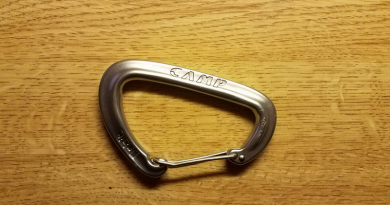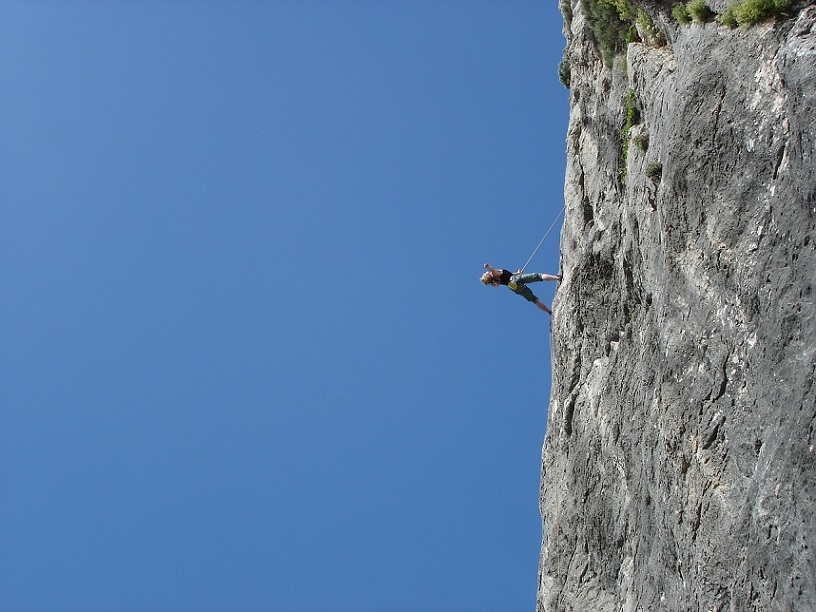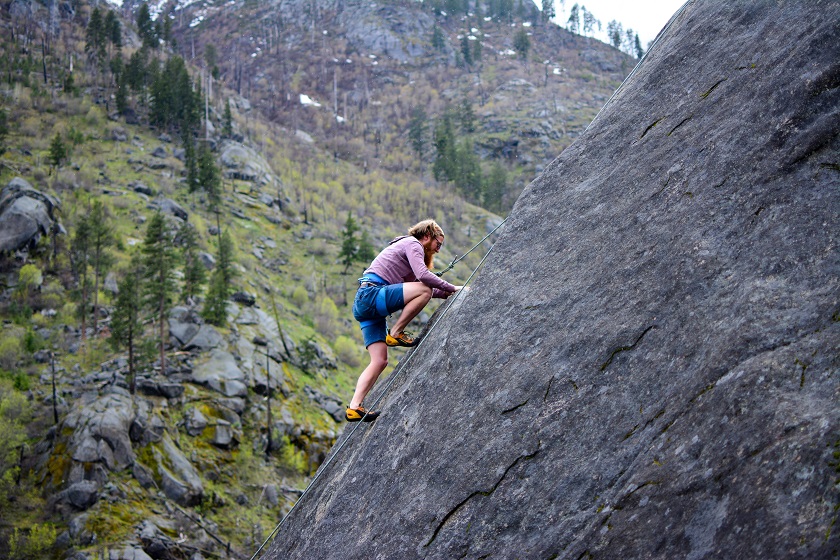Bolts and hangers help keep you safe on the rocks, but how much do you really know about them?
Though it can be all too easy to put blind faith into bolts and hangers you find when climbing outdoors, consider this: over time this equipment begins to corrode and lose strength, putting climbers at risk of serious injury.
Unfortunately, this has already started to happen in some of the most-popular climbing destinations across the globe. For this reason, every climber must know how to check the safety of the different bolts and hangers they find while climbing.
Below, I’ll go over what you need to know in order to start enjoying safer climbs. Keep this information in mind both as you buy new bolts and as you encounter them during your climb.

What Are Bolts and Hangers Used For?
If you’re new to climbing, you may have only heard of bolts and hangers. If you’re climbing has so far been relegated to being inside a climbing gym, it’s likely the case that you’ve never gotten a chance to use them.
These handy pieces of equipment can help secure a climber while on the rocks outdoors. To use a bolt and hanger, a climber first drills a hole into the rockface and prepares a bolt. These permanent pieces of protection will then be placed into the rockface and left for other climbers to use as well.
Hangers prove to be another vital piece of equipment. Climbers use quickdraws to attach to hangers, providing them with better security while climbing.
The goal, of course, is to keep them from falling to the bottom while up on the rocks. However, it’s not difficult to imagine how this can go wrong if the bolts have gone bad.
A rusted bolt that once could support the weight of a fully-grown, muscled man may, in time, find that it can no longer support the weight of the average climber.
And this spells trouble. Climbers who depend on these bolts for their safety could find themselves in serious peril should their bolts not hold up.
Unfortunately, a growing number of climbers doesn’t have what it takes to tell whether a bolt is safe or not before attaching themselves to it. Because here’s the thing: it’s pretty easy to know that a bolt is bad after it breaks.
The goal of this article is to make sure that you can diagnose a bad bolt before it endangers your life.
First, however, let’s take a more detailed look at the different kinds of bolts and hangers available.
What Size Bolts Are Used for Climbing Holds?
When it comes to bolts, climbers typically use a variety of sizes in order to get the job done.
Importantly, these bolts can be measured in two ways: their diameter and their length. Bolt diameter refers to how far across diagonally the bolt is, and this size can typically range from 3/8 of an inch to 1/2 inch.
Additionally, bolts can measure between 2 inches and 3 1/2 inches in length.
The size of the bolt you need will largely depend on the type of rock that it is being put in. For example, softer rocks typically need bolts that are larger both in diameter and in length. For this reason, if you plan to go climbing on soft rocks, a 3 ½” bolt with a ½” diameter may prove the best option for you.
How Long Do Bolts and Hangers Last?
The lifespan of bolts and hangers depends largely on a number of factors. From unintentional chemical reactions to natural corrosion, bolts and hangers can kick the can much more quickly than people realize.
But how long do they last on average?
It’s hard to tell. Now, it appears that the bolt lifespan may not be as long as some would believe. With many bolts already going out after only about twenty years, many climbers now want to find ways to keep their bolts stronger for longer.
Ultimately, one of the most important considerations that one can make when determining the lifespan of a bolt is the bolt’s material. Because here’s the thing: not all bolts are created equally.
In fact, it’s not even close. Some bolts are especially-susceptible to degrading factors, meaning that they will give out more quickly over time. Though this typically happens over a period of 10-15 years, under the right conditions, it can happen in as little as a few months.
For this reason, consider the information as you look to safely diagnose the health of rock climbing bolts. With this knowledge, you can better predict the safety of a bolt before placing your weight on it.
Materials
Climbing bolts can be made from a number of materials, but the most common one is steel.
Made of iron, steel has become one of the most common materials used in the construction of rock climbing bolts. However, steel comes in a variety of different forms. Understanding the chemical composition of these different forms of steel can provide critical insight into the strength of a climbing bolt.
Carbon Steel
When you think of old, rusted steel, it’s likely that you’re thinking of basic carbon steel. Though not quite as immune to fatigue and erosion as other types of steel, carbon steel allows for climbers to quickly tell if it’s safe or not.
That’s because carbon steel can get a characteristic rusted look. The iron within the steel reacts with oxygen in the air—and any other environmental factors that may be present. Once this happens, the steel will begin to rust and become dangerously unsafe.
Carbon steel bolts tend to be zinc-plated. This zinc can protect against rust for a short period of time, but it too will eventually disappear after reacting with oxygen.
Stainless Steel
Stainless steel proves to be another type of popular bolt-making material. While it provides for a stronger bolt overall, stainless steel comes complete with its own set of challenges.
Most notably, stainless steel can look completely okay, even while being rusted and rotted on the inside.
Stainless steel is formed by adding other metals into steel’s chemical makeup. These metals worked to give stainless steel a regenerative property that makes it immune to rust.
But don’t let this fool you, however. Though corrosion may not be apparent on the outside, there could be serious problems hiding beneath the service.
Titanium
Titanium proves to be the strongest of the bolt metals by far—but titanium bolts are relatively new on the market.
With this in mind, let’s take a closer look at the drawbacks of each of these materials.
What Causes Bolts to Corrode?
If given enough time, all bolts will corrode.
However, given the right conditions, they can do so in a matter of months. For this reason, it’s imperative that you understand the different processes of corrosion. This will allow you to better predict the safety of outdoor rock climbing bolts.
1. Galvanized Corrosion
Bear with me now, as the explanation behind this term gets a little scientific.
Galvanized corrosion occurs when a positively-charged and a negatively-charged element come into contact.
When this happens, ions will begin to flow from one metal into the other, making the metal weaker.
Climbers can speed up galvanized corrosion by hooking a different-metaled hanger onto a bolt. For example, if a stainless steel hanger is placed on a carbon bolt, the process of galvanized corrosion will begin. This will work to reduce the strength of the bolt—even though you won’t be able to see this with the naked eye.
2. Crevice Corrosion
Other forms of corrosion, such as crevice corrosion, rely on the environment to create unsafe conditions. Crevice corrosion, for example take chlorine from moisture in the atmosphere to start undermining the integrity of the bolt’s structure.
The buildup of chlorides can be particularly acute in areas near the ocean, but crevice corrosion is a problem in nearly all environments. Because chlorine can come through other sources such as the rain, crevice corrosion remains a problem in all moist environments.
Crevice corrosion with stainless steel bolts can be particularly dangerous, as the bolt may not appear to be affected.
3. Stress Corrosion Cracking
Stress corrosion cracking (SCC) refers to the dangerous incident in which a corroded bolt breaks under the weight of a climber or their fall.
As you can imagine, SCC poses a serious safety risk to climbers. Unfortunately, it looks to be a growing problem as the number of aged and corroded bolts on public routes continues to increase.
How Does the Environment Influence the Lifespan of Bolts and Hangers?
Keep in mind that the environment can have a major influence over the lifespan of both bolts and hangers.
Primarily, hot and humid environments tend to rust bolts faster than dry ones do. The oxygen found in water works to react with iron to form rust in carbon-steel bolts. Additionally, the build-up of chlorides in both stainless and carbon steel can significantly harm the integrity of the bolt.
These processes can be aided by the heat.
So what does this mean for you? Make sure that if you’re in a wet, hot environment, be sure to carefully examine bolts before using them.
How Can You Tell If a Bolt Is Still Good?
It’s always best to be aware of your surroundings when going climbing. If you’re in an area such as the one described above, make sure that you take extra time to examine the bolts along the route.
Additionally, be on the lookout to see if any of the bolts are exposed. To do this, look for any areas in which the rock face may be cracked or even chipped away. If you see these instances, consider replacing the bolt.
Furthermore, if you see any obvious indicators of corrosion—such as rust—on the bolt, be sure not to use it.
Should I Use Different Bolts and Hangers for Different Stone Types?
You may choose to vary the length and size of your bolts and hangers depending on the type of stone you’re climbing.
Remember, as stated, softer rockfaces will require longer and larger bolt sizes, while the opposite is true in reverse.
Additionally, note that different kinds of strength may be required for differing kinds of rock. Tensile strength becomes a factor, for instance, when climbing with softer rocks, as you may be in danger of pulling the bolt from the structure.
In normal conditions, you can expect that your bolts, no matter the size, will be able to support your weight. For these conditions to be met, the bolt must be properly fastened and screwed into the rock face.
Whether you’re working with 1/2” or 3/8” bolts, you can be certain that they can carry your weight—plus some—so long as they’re in good condition.
It’s worth noting here that this is true even if you fall. Additionally, falling has not been shown to significantly affect the strength of bolts in any way.
The Bottom Line
Determining the strength of rock climbing bolts and hangers can make or break your climb.
Always make sure your hangers are CE/UIAA certified, like for example these excellent hangers.
Before putting your weight onto a bolt, be sure to examine it for any potential signs of damage. If spotted, consider changing the bolt so that you can climb safely.
However, as discussed, it can be difficult at times to see some forms of bolt corrosion. This can be due both to environmental and elemental conditions, making it hard for climbers to know which bolts are safe—and which aren’t.
In these circumstances, climbers are encouraged to use the information above to judge the safety of their bolt. In doing so, keep in mind that dated bolts in wet, humid, and hot areas typically give out much faster than others—sometimes in as little as two years.
When selecting bolts for use on your climb, remember to choose the size and the material that work best for you. Keep in mind that the softer the rock, the larger the bolt.
For this reason, the type, size, and length of the bolt you use may ultimately come down to the rocks you’re climbing.
With the right bolts in store—and with your eyes trained to spot weak equipment—you can start enjoying safer climbs in no time.








Hi Alex,
Your blog is informative for both rock climbers and enthusiasts. Safety is paramount in any climbing task. Even if all bolts and hangers are new, any climber should be extra careful as they ascend the rock. This blog is definitely an asset!
Thanks Lydia, I appreciate it!